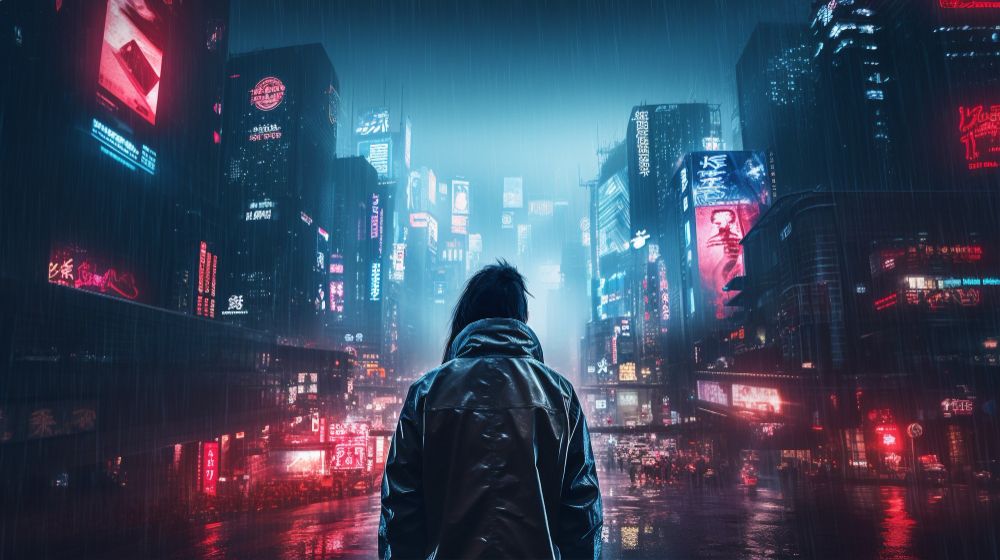The 'real' space of the Cyberpunk: A reflection
It's impossible to move, to live, to operate at any level without leaving traces, bits, seemingly meaningless fragments of personal information.― William Gibson

What are the narrative spaces of cyberpunk? Where are its stories set and told? Where are its dystopian perspectives and its "transhumanity" put into practice? Is it a techno-urban genre? Social science fiction? Is it a form of techno-surrealism? Cyberpunk is first and foremost a communication strategy. Its spaces are visionary and social scenarios, garages and skyscrapers, minds gone mad and streets filled with neon and lights. But in all of this, it is always communication. Communication that is reinforced or fragmented, that tries to connect things, people, neighborhoods, light and darkness. The data.
It's impossible to move, to live, to operate at any level without leaving traces, bits, seemingly meaningless fragments of personal information.
― William Gibson
Cyberpunk cities
Liquid identities and continuous data overloops fill the spaces of cyberpunk. They are waiting zones, crossed by individuals who are trying to resist or who have already given up. Cyberpunk cities are cutting-edge but broken and cracked-offs. Every urban element bears witness to a highly centralized economy surrounded by endless expanses of claustrophobic sprawl. Power uses surveillance technology against an existential dimension that is often anarchic and always on the edge. Life in cyberpunk is in the ruptures. Space is enclosed and dispersed between the peripheral, cacophonous sprawl and the hypertechnological centers.
Cyberspace is colonising what we used to think of as the real world. I think that our grandchildren will probably regard the distinction we make between what we call the real world and what they think of as simply the world as the quaintest and most incomprehensible thing about us.
― William Gibson

The interzone
Is the interzone the cyberpunk space? Brain-computer interzone; metropolis-periphery interzone; cyberspace-consciousness interzone; I-us interzone. Cities are the space of overlapping, where men and women lose coherence and become projections of desires and antidesires. And then there is the interzone between virtual space and real space: seeing, touching, feeling and acting at a distance, in a space that is no longer a physical space but a projection. Consciousness and body recompose their shared space in the machine, and thus in cyber instrumentation: data gloves, augmented reality goggles, cyber suits (exoskeletons), grafts, augmentations, and so on. It is almost as if the "disembodied" cyberpunk "character" is trying to reconnect to his or her real body through the transplants, reaching beyond the body to retrieve the dispersed self in the virtual interzones of existence into which he or she has unwisely ventured.
He turns off the techno-shit in his goggles. All it does is confuse him; he stands there reading statistics about his own death even as it's happening to him. Very post-modern.
― Neal Stephenson
The continuous flow of data
In all his greatest cyberpunk novels, William Gibson decries this anthropological revolution: There is a new "social subject" that wanders through cities like a datum that travels from one node to another, having lost a fragment of itself after each round trip. And this virtual habitat leads to another consequence, namely a rhizomatic view of society. At the "First Galactic Congress of Hackers", Lee Felseinstein stated that interpersonal communication has been destroyed by the global village. Therefore, cyberpunk would choose to found a new, interactive, anti-corporate, uncontrollable model: The continuous flow of data. Is this constant data stream the true cyberpunk space?

Insights
Cyberpunk Culture. Network, Conference, Publications
Cyberpunk: A Short Bibliography
- Grella, George. “Murder and the Mean Streets: The HardBoiled Detective Novel.” Contempora, March: 1970.
- Groden, Michael, and Martin Kreiswirth. The Johns Hopkins Guide to Literary Theory and Criticism. Baltimore, MD: The Johns Hopkins University Press, 1994.
- Jameson, Frederic. Postmodernism. or the Cultural Logic of Late Capitalism. Durham: Duke University Press, 1991.
Novels
- Gibson, William. Burning Chrome. New York: Ace Books, 1987.
- Gibson, William. Count Zero. New York: Ace Books, 1987.
- Gibson, William. Mona Lisa Overdrive. New York: Bantam Spectra Books, 1989.
- Gibson, William. Neuromancer. New York: Ace Books, 1984.
- Gibson, William. Virtual Light. New York: Bantam Books, 1993.
- Stephenson, Neal. Snow Crash. New York: Bantam Spectra Books, 1993.
- Sterling, Bruce. Islands in the Net. New York: Ace Science Fiction, 1989.
- Sterling, Bruce, ed. Mirrorshades: The Cyberpunk Anthology. New York: Ace Science Fiction, 1986.
- Bukatman, Scott. Terminal Identity. Durham: Duke University Press. 1993.
- Cadigan, Pat. Fools. New York: Bantam Books, 1992.
- Cadigan, Pat. Mindplayers. Bantam Books, 1987.
- Cadigan, Pat. Synners. New York: Bantam Books, 1991.
- Carpenter, John. Escape from New York. Los Angeles, CA: AVCO Embassy Pictures, 1981.
- Davis, Mike. City of Quartz. New York: Vintage Books, 1990.
